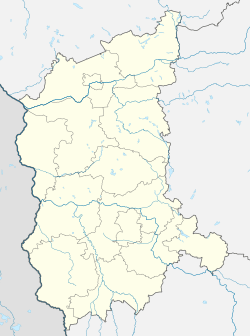Babimost
Babimost [baˈbʲimɔst] (German: Bomst) is a small town in western Poland in Zielona Gora County, Lubusz Voivodeship. It is the administrative seat of Gmina Babimost.
Babimost | |
|---|---|
.jpg) Town center with the town hall | |
 Flag  Coat of arms | |
 Babimost  Babimost | |
| Coordinates: 52°9′N 15°49′E | |
| Country | |
| Voivodeship | Lubusz |
| County | Zielona Góra |
| Gmina | Babimost |
| Town rights | 1397 |
| Area | |
| • Total | 3.62 km2 (1.40 sq mi) |
| Population (2019-06-30[1]) | |
| • Total | 3,926 |
| • Density | 1,100/km2 (2,800/sq mi) |
| Time zone | UTC+1 (CET) |
| • Summer (DST) | UTC+2 (CEST) |
| Postal code | 66-110 |
| Area code(s) | +48 68 |
| Vehicle registration | FZI |
| Climate | Cfb |
| Website | http://www.babimost.pl |
Geography
The town is situated on the Leniwa Obra creek, about 20 km (12 mi) northeast of Sulechów and about 75 km (47 mi) west of Poznań. Though located in Lubusz Voivodeship, Babimost is part of the Greater Poland historic region.
History
.jpg)
The settlement probably arose about 1000 AD around a castellany located at a crossing through the swampy Leniwa Obra river. The estates were held by the Pomeranian Swienca family until 1307; together with nearby Sulechów, they were acquired by Margrave Waldemar of Brandenburg in 1319, who nevertheless died in the same year. By 1329, they were held by the Silesian duke Henry IV the Faithful, then a Bohemian vassal. Finally incorporated into the Polish Poznań Voivodeship in 1332 (which was later also part of the larger Greater Poland Province of the Polish Crown), Babimost received town privileges according to Magdeburg Law by King Władysław II Jagiełło in 1397. It was a royal town of Poland.
King Sigismund the Old confirmed the city rights in 1530. After the Protestant Reformation, the population increased due to the influx of religious refugees from Silesia. In the mid-17th century, the starost of Babimost was Krzysztof Żegocki, who during the Swedish invasion of Poland was the first to organize a guerrilla unit to fight the invading forces and became famous in the battles of Kościan and Jasna Góra, thus earning the title of the "First Partisan of the Commonwealth".[2] During the war, which was part of the Second Northern War, Babimost was devastated by Swedish troops in 1656. The reconstruction of a synagogue is documented around 1700, a Protestant church was erected in 1782. The inhabitants were mainly shoe manufacturers, linen producers and hop (beer) and wine producers.
Upon the Second Partition of Poland in 1793, the town fell to Prussia. In 1807, it was regained by Poles as part of the short-lived Duchy of Warsaw. At the Congress of Vienna in 1815, it again passed to Prussia, and was incorporated into the Grand Duchy of Posen. Prussians conducted a policy of Germanisation towards the local population.[2] German was introduced in Polish schools, German colonists were settled to change the ethnic composition.[2] Between 1818 and 1938 it was part of the Bomst district within the Prussian Regierungsbezirk Posen, though the administrative seat was at Wollstein (Wolsztyn). When the town became part of the German Empire in 1871, it had 2272 inhabitants, of whom 1042 were Catholics (mostly Poles), 1070 were Protestants (mostly Germans) and 160 Jewish. Despite attempts at Germanisation, Poles founded new organizations in the town, including an agricultural association (Kółko Rolnicze), People's Bank (Bank Ludowy) and the Catholic Association of Polish Youth (Katolicki Związek Młodzieży Polskiej).[2]

After Poland regained independence in 1918, Poles from the town and the surrounding area actively joined the Greater Poland Uprising to rejoin the area with Poland.[2] On January 24, 1919, the insurgents captured Babimost, but under the Treaty of Versailles the town remained within Germany.[2] In the interwar period, the town lay on the border with the Second Polish Republic; remaining with the German province of Posen-West Prussia and from 1938 to 1945 as part of the Province of Brandenburg, while up to a third of its residents were Poles. Attempts at Germanisation intensified, in response Poles set up private schools, gathered in theater groups and choirs, Polish press was spreading, and Polish organizations were active.[2] In 1939, 1950 inhabitants were registered as citizens of the town, of whom 600 were ethnic Polish. During the German invasion of Poland, in September 1939, the Germans arrested several regional Polish activists (including local Polish leader Jan Cichy),[2] who were then deported to Nazi concentration camps, and later also expelled several Polish families from the county.[3]
After the Vistula–Oder Offensive of the Red Army in the late days of World War II, large parts of the town lay in ruins. In 1945, Babimost was reintegrated with Poland and its German population was expelled by the local administration.
Transport
.jpg)
There is a railway station in Babimost and the Zielona Góra Airport is located nearby.
Twin towns – sister cities
See twin towns of Gmina Babimost.
See also
- List of cities in Poland
References
- "Population. Size and structure and vital statistics in Poland by territorial divison in 2019. As of 30th June". stat.gov.pl. Statistics Poland. 2019-10-15. Retrieved 2020-04-11.
- "Historia / Babimost". Powiat Zielonogórski - Starostwo Powiatowe w Zielonej Górze (in Polish). Retrieved 10 October 2019.
- Mirosław Cygański, Hitlerowskie prześladowania przywódców i aktywu Związków Polaków w Niemczech w latach 1939 - 1945, "Przegląd Zachodni", nr 4, 1984, p. 49-50 (in Polish)
- "Klon Babimost - Oficjalna strona internetowa klubu piłkarskiego" (in Polish). Retrieved 11 June 2020.
External links
- Jewish Community in Babimost on Virtual Shtetl
| Wikimedia Commons has media related to Babimost. |